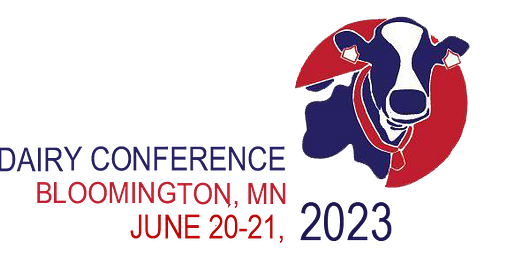Why you should be attending the Precision Dairy Conference next month
Plus, former Apple exec shows off new hands-free, AI-powered, machine vision ‘device’
Whether you’re a producer, consultant or tech company employee, the Precision Dairy Conference is the must-attend conference of the year. Unlike other conferences, all technologies for cows – those starting up, scaling up or established – are welcome at the Precision Dairy Conference. Conference organizer Marcia Endres, dairy scientist and extension educator for the University of Minnesota, says the conference is a “neutral space” for all cow technology companies.
“It’s not a scientific event,” Endres says. “It’s a producer and industry event. All technologies are welcome.”
The conference is an opportunity to learn from real-life end users of technology, including farmers themselves, and network and discuss the benefits and roadblocks to technology adoption.
What I personally like about the conference is the relatively short presentations (20 minutes) that are always followed immediately by discussion and audience input (another 30 minutes). The conference also has regular networking breaks to help like-minded cow tech futurists connect with each other.
“The discussions are really lively. And I think that’s very unique to this event,” Endres says.
The following topics are on this year’s agenda:
Up-and-coming technologies
Sustainability measurement
Labor management
Cow animal welfare and health monitoring with tech
Data integration and acting on insights
See the full conference agenda here.
I’ll be in attendance and presenting, plus co-moderating a panel of new technology providers. While there are a growing number of technology conferences out there, this is the one not to miss if you want to interact with the first-movers who are helping tech get an actual foothold on dairy farms.
The conference hotel block closes at the end of this month and early registration runs through the first part of June. Get signed up to attend the conference here.
Rumen microbe manufacturer wins grant to develop saliva-based test for enteric methane emission measurement
Biotechnology company Native Microbials recently won a $1.4 million grant from the USDA to study the potential enteric emissions decrease from feeding its microbial feed supplement Galaxis Frontier. The project also received funding to develop a scalable, non-invasive protocol for measuring enteric methane emissions on-farm. That development will focus on creating and testing an oral-based microbiome methodology to accurately measure enteric methane emissions on dairies.
“Current technologies for monitoring EME are low-throughput and costly, and often require large pieces of equipment that are not easily transported over long distances,” says Brooke Anderson, PhD, of Native Microbials. “If our work is successful, all that will be required in-field are generic cotton swabs to collect a small sample of saliva from a handful of cows. These swabs can then be shipped to any molecular biology lab for a follow-up experiment to quantify experimentally-identified microbiome markers that correlate with enteric methane emissions.”
The company says the in-field test, if successful, could potentially be applied for use on any ruminant animal operation.
“We hope that this is the first of many partnerships with the USDA as we continue to develop innovative solutions to support sustainable agriculture,” Anderson says.
Read more about the grant here.
Former Apple exec shows off new hands-free, AI-powered, machine vision ‘device’
Former director of design for Apple Imran Chaudhri sees a future of technology that is hands-free. The 20-year-plus veteran of the tech industry recently showcased his vision for how users could soon interact with technology, machine vision and AI during a recent TED Talk. What he imagines is a cell phone, camera and digital assistant all wrapped into one and small enough to be a personal accessory like a lapel pin or eye glasses attachment.
Watch Chaudhri’s “hands-free” interaction here.
Watching the demonstration, I had visions of the benefits of such technology for herdsmen and pen riders. For example, the machine vision and AI of the minimalist device he showed could be used to actively assist with cowside herd checks.
Chaudhri believes “the ultimate interface with computing is one that completely disappears.” He is currently the chairman and president of Humane, an organization building innovative technology that “improves the human experience and is born from good intention.”
$1.4 billion
According to a report by Grand View Research, the global automated dairy management systems market size was valued at $1.4 billion (USD) in 2020 and is expected to reach $2.9 billion by 2028.
New sustainability assessment tool for cow tech available
The State of California and the Netherlands recently launched a new joint project to help producers assess the impact of adopting specific technologies on their farm’s sustainability efforts. The new assessment tool currently highlights more than 75 globally available technologies for their positive, neutral or negative impact on enteric methane, manure management, labor, sustainability measurement and animal welfare.
The group behind the assessment tool says their goal is to review solutions already available or soon to be available and then “identify the gaps and work together to support the introduction of new technology and facilitate the commercialization of technology to address the needs of the industry.”
See Vine’s new assessment tool and read more about it here.
Feed mixer manufacturer launches development center
Global feed equipment manufacturer Triolet recently opened a new corporate center for software and hardware development in the Netherlands. The center includes permanent installations of feeding robots, feed kitchens and stationary mixers to test and develop advanced feeding solutions. It will also serve as home for the company’s global cloud and telematics monitoring system.
The aim of the center is to develop feeding routines that are faster and more efficient.
Project aims to lower enteric methane emissions with rumen microbe gene editing
UC-Davis recently announced a $70 million grant to research using CRISPR technology to edit the genome of rumen microbes and potentially reduce enteric methane emissions. Researchers hope to be able to prove they can edit the genes of methane-producing microbes so they produce less methane and then demonstrate they can plant those microbes in calves at a young age so they become the dominate rumen microbiome as the calf grows and begins to ruminate.
Read more about the project to edit the genes of rumen microbes.
Dairy profit projections from ZISK
Projected profitability for the next 12-month for two dairy herd sizes HAVE INCREASED in recent profit projections from ZISK.
ZISK is a profit-projection smartphone app that tracks individual dairy farm profitability based on current CME board prices. Projections for a 1,000-cow dairy producing an average of 80 pounds of milk per cow and a 2,500-cow dairy producing an average of 85 pounds of milk per cow are provided.
12-month dairy farm profit projections (as of May 11, 2023):
1,000-cow dairy = $315,500 (UP about $31,000 since the middle of April)
2,500-cow dairy = $1.522 million (UP about $61,000 since the middle of April)







